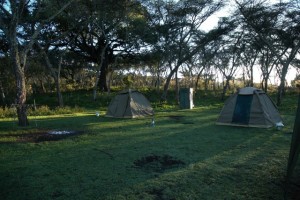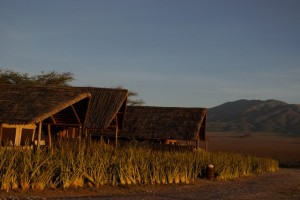It is 6:30am and a rap on the side of the dome tent we are sleeping in is our wake up call. We must get an early start in case (1) it rains, we want to get as far as possible before it does or (2) we are slow going up or down.
Breakfast is a real camping breakfast, only with a cook in a white chef’s coat. Eggs, croissants, PB, jam, fruit. We sort through the packed lunch and discard what we won’t eat, no use lugging it up the mountain and down again.
The local crew doesn’t seem to panic about time yet today our hiking guide and Pascel, our safari guide want us to jump to so we get more time to walk in the cool morning.
Up we go. Pole, Pole. Quite a steep climb. The pace is good. Sumati, our Maasai hiking guide leads. He stops every 500 meters or so for everyone to bunch up. Toumani, our ranger with a semi-automatic rifle, brings up the rear. We parade up the mountain single file high stepping to avoid the cow poop.
We all chat as we ascend; we learn about the ways of the Maasai and Chunga (Toumani’s people) and they about Canada and Canadians. Cresting what appears from the bottom to be the peak, we see the real peak not far but still up. Between us and our goal is a stretch of forest. Sumati says to be quiet as there are many animals here. So now the column is silent.
There are no trails except the cow tracks in the grassy areas and wild animal trails in the forests. That’s what we follow. All along the path are signs of cape buffalo having just passed by. Runny poop, some of it steaming.
Sumati spots a buffalo or two a few meters (like 100M) away. We watch them stumble through the forest. He hears several more go romping into the dense trees. They must have sensed us and got spooked. Toumani jumps into action. Unlocks his gun and walks on alert between us and where we spotted the beasts. He is all about caution and maybe a bit of drama as I do not think the animals are much of a threat.
This hike we are on is 15 km, a long way at the best of time but this walk is really taking its toll. The first 2 km is up and quite steep, the next 3 are down and also quite steep, then comes the hard part, 10 km of undulating terrain with negative elevation gain, a good portion of which is on fist size rolling rocks. Foot placement is all important. Debbie and L are having a difficult time of it.
At the foot of the mountain we connect to “The Road of Cows” (I think this is a generic name not specific to the road on which we trod). The road leads us to a cluster of Maasai villages.
Each enclosure is a “village”. It houses a family unit. It would be more like an acreage or yard to us westerners. The cluster of villages are the homes of relatives and others, and would be more like what in the west would be considered a village.
As we arrive at each village we are greeted by the inhabitants. Mostly women, the men are off tending the animals, and a few children, the ones not in school. They show us handicrafts they have been making to adorn themselves and family and to sell to the occasional tourist that happens by this area.
Debbie and L commit to purchasing a trinket or 2 from one the villages. We stop and are immediately surrounded by women selling their beaded goods. L and Debbie choose a couple of items each, bargain a little and walk away with beads on their wrist. The sales technique is somewhat different here. Only one or two of the women do the selling. The merchandise is provided by all in the village. Money made is communal funds and is put towards beads and supplies to create more jewellery.
The men and boys of the villages spend the days tending livestock – cows, sheep, goats and donkeys. Each day the animals are taken from the stockade to graze nearby and each evening they are gathered and ushered home to the protection of the village corral. The livestock is not only the source of food for the Maasai (the Maasai do not hunt nor eat wild meat) but are a form of currency, used to purchase fruit, vegetables and grains and for such things are dowry.
Passing through this area I feel it is a unique part of Africa that most tourists do not get to see. It maintains a traditional lifestyle not affected a great deal by modern life.
With 8 of the 15 km remaining, we leave the villages behind and start a long descending trail to the plains on the Serengeti. The going is tough with the rolling rocks. Fatigue is setting in and concentration is not as sharp as it was 4 hrs. ago. We are not as careful about avoiding the animal dung as we were when we started out.
We are all fatigued, R, L and Debbie are showing signs of a long day, but I am managing to hide them. Toumani must be impressed; he asks me if I am a soldier. I’m puzzled and say no and ask why? He says I am still looking strong and we have come a long way.
Getting on to 9.5 hrs. since we started out, we reach the rendezvous with Pascel and our ride to the next hotel. Before we climb in to the Landcruiser I locate my stash of pop and offer all the walkers a can. Coca Cola for everyone!
The Olduvai Lodge is our destination. NICE place, very NICE. Located in a small caldera and not another place in sight. It is remote. It is also the nicest place we have stayed. It is a tented lodge which means the rooms are surveyors’ tents, but this one is luxury, high class beds and furnishings with an open air ensuite at the rear that is sculpted from concrete and sheltered by a thatched roof.
It only took 15 km to go from roughing it in the wilderness to settling in in the lap of luxury.




